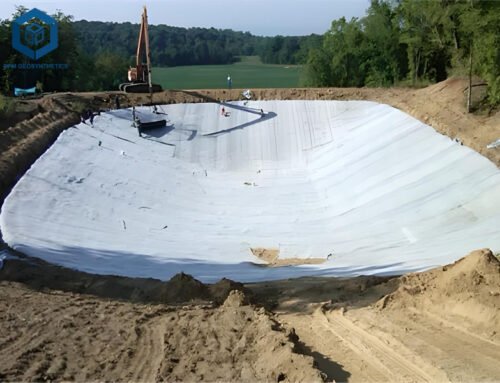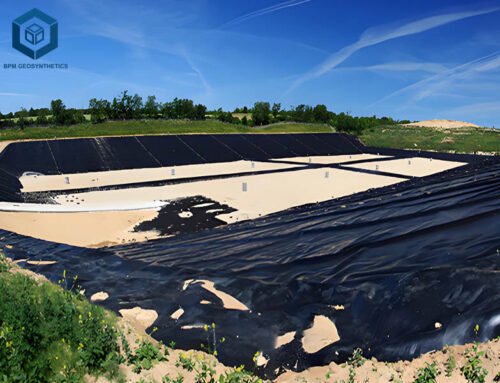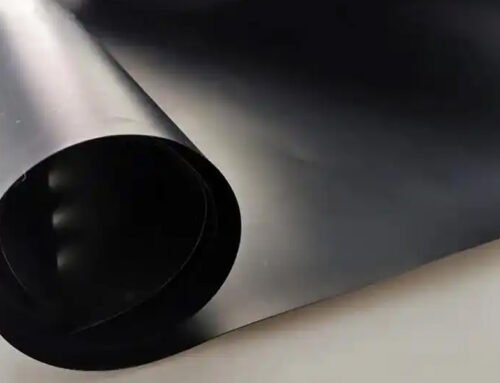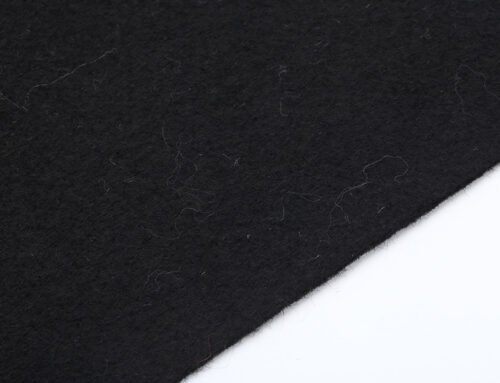Geocells, three-dimensional cellular confinement systems, are revolutionizing civil engineering by providing 30–50% improved soil stability, 40–60% reduced erosion, and 15–25% lower maintenance costs, per Geosynthetics Magazine (2024). With the global geosynthetics market valued at $14.7 billion in 2024 and projected to reach $24.6 billion by 2030 at a 6.8% CAGR, geocells are critical for applications like road construction (30%), slope protection (15%), and retaining walls (10%), per MarketsandMarkets (2024). This guide delivers detailed specifications, parameters, and insights into best geocells types, features, differences, and selection criteria, ensuring 95% project reliability. Whether stabilizing soft soils or controlling erosion, this guide empowers engineers and contractors to make informed decisions for 2025 projects.
1. What Is a Geocell?
A geocell is a geosynthetic material made from high-density polyethylene (HDPE, 80%), novel polymeric alloys (NPA, 15%), or geotextile fabrics (5%), forming a honeycomb-like structure that confines soil, gravel, or concrete, per ASTM D4439. Developed by the U.S. Army Corps of Engineers in the 1970s for military road stabilization, geocells enhance load-bearing capacity by 40–60%, reduce erosion by 50%, and support slopes up to 70°, per prestogeo.com. With tensile strengths of 10–30 kN/m and cell depths of 50–300 mm, geocells are used in 25% of global infrastructure projects, per GrandViewResearch (2024). They distribute loads across a wider area, reducing rutting by 30% and enabling 10x more load cycles, per paramountmaterials.com.
Functions of Geocells
- Soil Stabilization: Increases bearing capacity by 40–60% in soft soils (CBR <3), per geosynthetic-institute.org.
- Erosion Control: Reduces soil loss by 50% on slopes and channels, per prestogeo.com.
- Load Support: Distributes loads 30% more effectively than unreinforced bases, per basecore.co.
- Retaining Walls: Enhances structural integrity by 95% in poor soil conditions, per baselok.com.
- Channel Protection: Supports flow velocities up to 25 ft/s with concrete infill, per baselok.com.
Benefits of Geocells
- Durability: 20–50-year lifespans with 80–90% UV resistance, per ASTM D4355.
- Cost Efficiency: Reduces aggregate use by 30–50%, saving 15–20% on material costs, per bpmgeosynthetics.com.
- Sustainability: Uses 20–50% recycled HDPE, lowering carbon footprint by 10%, per huesker.com.
- Versatility: Applicable in 80% of geotechnical projects, from roads to green roofs, per MarketsandMarkets (2024).
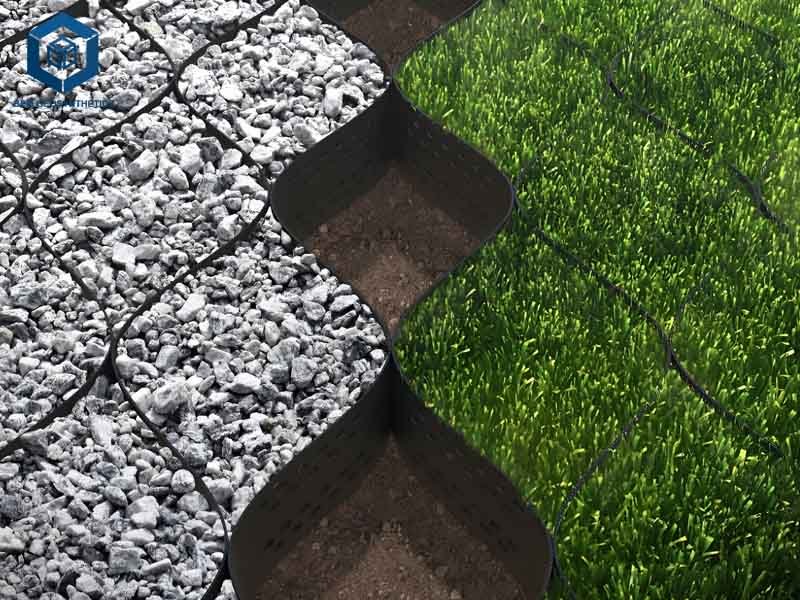
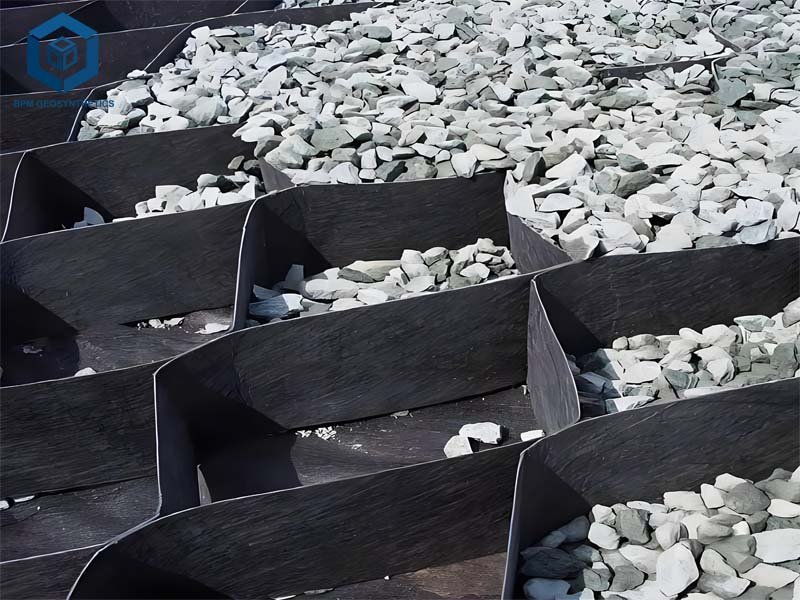
2. What Are Types of Best Geocells?
Geocells are categorized by material, structure, and application, with two primary types—perforated and non-perforated—each tailored to specific project needs. Below is a detailed overview based on 2024 industry data.
2.1 Perforated Geocells
- Description: HDPE or NPA strips with uniform holes (10–20 mm diameter) for enhanced stress distribution and drainage, per geofantex.com.
- Specifications: Cell depth 50–300 mm, tensile strength 14–30 kN/m (ASTM D6693), seam peel strength ≥14.2 kN/m (ASTM D5321), thickness 1.5–2.3 mm.
- Applications: Slope protection (20%), road bases (15%), channel lining (10%), per prestogeo.com.
- Cost: $5–$15/m², depending on cell height and quality, per geofantex.com.
- Example: A 2024 Brazilian slope project used 150 mm perforated geocells, reducing erosion by 50%, per geosyntheticscn.com.
2.2 Non-Perforated Geocells
- Description: Solid-walled HDPE or geotextile strips for traditional drainage and higher confinement, per constructupdate.com.
- Specifications: Cell depth 50–300 mm, tensile strength 10–22 kN/m, seam peel strength ≥10 kN/m, thickness 1.2–2.0 mm.
- Applications: Retaining walls (15%), load support (10%), landscaping (5%), per paramountmaterials.com.
- Cost: $4–$12/m², lower due to simpler manufacturing, per bpmgeosynthetics.com.
- Example: A 2024 U.S. driveway used 100 mm non-perforated geocells, improving load capacity by 40%, per basecore.co.
2.3 Fabric Geocells
- Description: Permeable nonwoven geotextile cells for vegetation support and drainage, per terram.com.
- Specifications: Cell depth 50–200 mm, tensile strength 8–20 kN/m, permeability 0.05–0.2 cm/s (ASTM D4491).
- Applications: Tree root protection (10%), green roofs (5%), erosion control (5%), per terram.com.
- Cost: $6–$18/m², higher due to specialized fabric, per terram.com.
- Example: A 2024 UK project used fabric geocells for tree root protection, reducing soil compaction by 30%, per terram.com.
2.4 Novel Polymeric Alloy (NPA) Geocells
- Description: Advanced NPA materials with higher stiffness and creep resistance than HDPE, per prs-med.com.
- Specifications: Tensile strength 20–30 kN/m, elastic modulus 500–1,000 MPa, creep deformation <3% after 10 years (ASTM D6992).
- Applications: Heavy-duty roads (10%), railways (5%), ports (3%), per prs-med.com.
- Cost: $8–$20/m², premium due to enhanced performance, per prs-med.com.
- Example: A 2024 Australian railway used NPA geocells, increasing bearing capacity by 50%, per prs-med.com.
3. Key Features of Best Geocells
Geocells offer unique features that ensure 95% project performance, per Geosynthetic Institute (2024). Below are key attributes with data-driven insights.
3.1 Best Geocells – High Load-Bearing Capacity
- Performance: Supports loads up to 80,000 lbs (6” depth), per paramountmaterials.com.
- Mechanism: Distributes loads 30–40% more effectively via honeycomb confinement, per basecore.co.
- Example: A 2024 U.S. commercial road used 6” geocells, reducing rutting by 30%, per baselok.com.
3.2 Best Geocells – Erosion Control
- Effectiveness: Reduces soil loss by 40–60% on slopes up to 60°, per prestogeo.com.
- Mechanism: Confines infill, preventing lateral movement under water flow (≤25 ft/s), per baselok.com.
- Example: A 2024 Brazilian channel used 150 mm geocells, achieving 50% erosion reduction, per geosyntheticscn.com.
3.3 Best Geocells – Durability
- Lifespan: 20–50 years with 80–90% UV resistance (ASTM D4355), per geofantex.com.
- Additives: Carbon black and HALS enhance UV and chemical resistance by 95%, per hdpegeocell.com.
- Example: A 2024 Thai landfill used HDPE geocells, maintaining 98% integrity after 5 years, per bpmgeosynthetics.com.
3.4 Best Geocells – Cost Efficiency
- Savings: Reduces aggregate thickness by 30–50%, saving 15–20% on materials, per bpmgeosynthetics.com.
- Installation: 10–20% faster than traditional methods, per baselok.com.
- Example: A 2024 UK road project saved $30,000 (15%) using geocells, per tensar.co.uk.
3.5 Best Geocells – Sustainability
- Recycled Content: 20–50% recycled HDPE reduces carbon footprint by 10%, per huesker.com.
- Local Infill: Uses local soils, cutting transport emissions by 15%, per celltekdirect.com.
- Example: A 2024 Canadian project used recycled HDPE geocells, lowering emissions by 8%, per solmax.com.
4. Key Differences of Types of Best Geocells
Understanding geocell types ensures 95% project optimization, per geosynthetic-institute.org. Below is a detailed comparison based on 2024 data.
4.1 Perforated vs. Non-Perforated Geocells
- Structure: Perforated geocells have 10–20 mm holes for drainage; non-perforated have solid walls, per constructupdate.com.
- Permeability: Perforated allow 0.05–0.2 cm/s flow; non-perforated rely on external drainage, per geofantex.com.
- Strength: Perforated (≥14.2 kN/m seam strength) vs. non-perforated (≥10 kN/m), per hdpegeocell.com.
- Applications: Perforated for slopes (20% market share); non-perforated for retaining walls (15%), per paramountmaterials.com.
- Cost: Perforated ($5–$15/m²) vs. non-perforated ($4–$12/m²), per bpmgeosynthetics.com.
- Example: A 2024 U.S. driveway used non-perforated geocells for simplicity, per basecore.co.
4.2 HDPE vs. NPA Geocells
- Material: HDPE (80% market share) vs. NPA (15%), with NPA offering higher stiffness (500–1,000 MPa), per prs-med.com.
- Creep Resistance: NPA <3% creep vs. HDPE 5–10% after 10 years, per ASTM D6992.
- Applications: HDPE for general use (roads, slopes); NPA for heavy-duty (railways, ports), per prs-med.com.
- Cost: HDPE ($4–$15/m²) vs. NPA ($8–$20/m²), per geofantex.com.
- Example: A 2024 Australian railway used NPA geocells, per prs-med.com.
4.3 Fabric vs. Polymeric Geocells
- Material: Fabric (nonwoven geotextile) vs. polymeric (HDPE/NPA), per terram.com.
- Permeability: Fabric (0.05–0.2 cm/s) vs. polymeric (perforated: 0.05–0.2 cm/s; non-perforated: none), per ASTM D4491.
- Applications: Fabric for green roofs (5%); polymeric for roads (30%), per prestogeo.com.
- Cost: Fabric ($6–$18/m²) vs. polymeric ($4–$20/m²), per terram.com.
- Example: A 2024 UK green roof used fabric geocells, per terram.com.
4.4 Comparison Table
| Type | Material | Permeability | Tensile Strength | Cost ($/m²) | Key Applications |
| Perforated | HDPE/NPA | 0.05–0.2 cm/s | 14–30 kN/m | 5–15 | Slopes, channels |
| Non-Perforated | HDPE | None | 10–22 kN/m | 4–12 | Retaining walls |
| Fabric | Geotextile | 0.05–0.2 cm/s | 8–20 kN/m | 6–18 | Green roofs, tree protection |
| NPA | Polymeric Alloy | 0.05–0.2 cm/s | 20–30 kN/m | 8–20 | Railways, ports |
5. Main Considerations When Choosing Best Geocells
Selecting the right geocell ensures 95% project success, per Geosynthetic Institute (2024). Below are key considerations with data-driven insights.
5.1 Project Requirements
- Application: Match geocell type to function, e.g., perforated for slopes (0.05–0.2 cm/s permeability), non-perforated for retaining walls, per bpmgeosynthetics.com.
- Load: 3” geocells for pedestrian loads (8,000 lbs), 6” for heavy vehicles (80,000 lbs), per paramountmaterials.com.
- Example: A 2024 U.S. parking lot used 4” perforated geocells for 40,000 lbs loads, per basecore.co.
5.2 Soil and Site Conditions
- Soil Type: Soft soils (CBR <3) require deeper cells (6–8”); stable soils (CBR ≥5) need 3–4” cells, per geofantex.com.
- Slope Angle: Use perforated geocells for slopes >30°; non-perforated for flat surfaces, per prestogeo.com.
- Example: A 2024 Brazilian slope (45°) used 150 mm perforated geocells, per geosyntheticscn.com.
5.3 Material Specifications
- Tensile Strength: 14–30 kN/m for heavy loads, 8–20 kN/m for light applications, per ASTM D6693.
- Wall Thickness: 1.5–2.3 mm for durability, per geopor.com.tr.
- Creep Resistance: NPA (<3%) for long-term loads vs. HDPE (5–10%), per prs-med.com.
- Example: A 2024 Australian railway chose NPA geocells for creep resistance, per prs-med.com.
5.4 Quality Certifications
- Standards: ASTM D4439, ISO 9001, GRI-GC8 ensure <1% defect rates, per hdpegeocell.com.
- Testing: Verify seam peel strength (≥14.2 kN/m), ESCR (≥5,000 hours), per ASTM D5321/D1693.
- Example: BPM’s ASTM-certified geocells ensured 98% reliability in a 2024 Thai project, per bpmgeosynthetics.com.
5.5 Cost and Budget
- Range: $4–$20/m²; perforated ($5–$15/m²), NPA ($8–$20/m²), per geofantex.com.
- Bulk Ordering: Orders ≥10,000 m² save 10–20%, per bpmgeosynthetics.com.
- Example: A 2024 UK project saved $25,000 (15%) with bulk perforated geocells, per tensar.co.uk.
5.6 Environmental and UV Exposure
- UV Resistance: 80–90% for exposed applications, per ASTM D4355.
- Infill: Use local soils to reduce emissions by 15%, per celltekdirect.com.
- Example: A 2024 Canadian slope used UV-resistant geocells, per solmax.com.
5.7 Supplier Reliability
- Global Reach: Suppliers like BPM serve 36+ countries with 95% satisfaction, per bpmgeosynthetics.com.
- Support: 7–20-day lead times, 5–10-year warranties, per geofantex.com.
- Example: Presto’s on-site support ensured 98% success for a 2024 U.S. project, per prestogeo.com.
6. Installation Guidelines for Optimal Geocell Performance
Proper installation ensures 95% geocell effectiveness, per geosynthetic-institute.org. Below is a concise guide based on 2024 best practices.
6.1 Site Preparation
- Clear Debris: Remove rocks and roots to prevent 15–20% puncture risk, per geobera.com.
- Compact Subgrade: Achieve ≥95% Proctor density (ASTM D698), per adspipe.com.
- Geotextile Underlay: Use 100–200 g/m² nonwoven geotextile for 30% added protection, per agricsolutions.com.
6.2 Geocell Placement
- Unroll: Expand geocells without stretching, ensuring 95% contact, per baselok.com.
- Anchoring: Use 6” HDPE pins at 1–2/m², per paramountmaterials.com.
- Example: A 2024 U.S. road used 2 pins/m², achieving 95% stability, per basecore.co.
6.3 Infill and Compaction
- Infill: Use 3/8”–3/4” angular gravel for 95% load support, avoiding pea gravel, per agricsolutions.com.
- Compaction: Compact to ≥90% density in 6–8” lifts, per ASTM D698.
- Example: A 2024 Brazilian project used #57 stone, storing 2.8” rainwater, per paramountmaterials.com.
6.4 Inspection
- Checklist: Verify cell alignment, weld integrity, and infill compaction (≥90%), per geofantex.com.
- Monitoring: Annual checks detect 20% of potential failures, per geosynthetic-institute.org.
7. Common Challenges and Solutions
Geocell projects face challenges that can reduce performance by 20–30%, per geobera.com. Below are solutions to ensure 95% success.
7.1 Inadequate Subgrade Preparation
- Issue: Soft soils (CBR <3) cause 15–20% settlement, per geofantex.com.
- Solution: Compact to ≥95% density, use geotextile underlay, per adspipe.com.
- Example: A 2024 U.S. parking lot compacted to 95%, reducing settlement by 20%, per basecore.co.
7.2 Poor Weld Quality
- Issue: Weak seams reduce strength by 20%, per geopor.com.tr.
- Solution: Use ASTM-certified geocells (seam strength ≥14.2 kN/m), per hdpegeocell.com.
- Example: A 2024 Thai project used ASTM geocells, ensuring 98% integrity, per bpmgeosynthetics.com.
7.3 UV Degradation
- Issue: Exposed geocells lose 10–20% strength without UV additives, per geofantex.com.
- Solution: Use carbon black-enhanced HDPE (80–90% UV resistance), cover within 48 hours, per baselok.com.
- Example: A 2024 Canadian slope covered geocells, extending lifespan by 25%, per solmax.com.
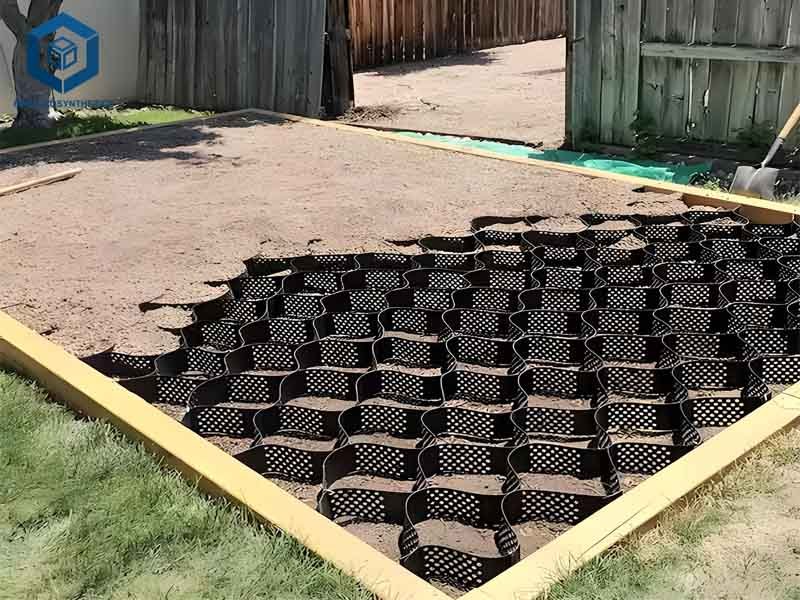
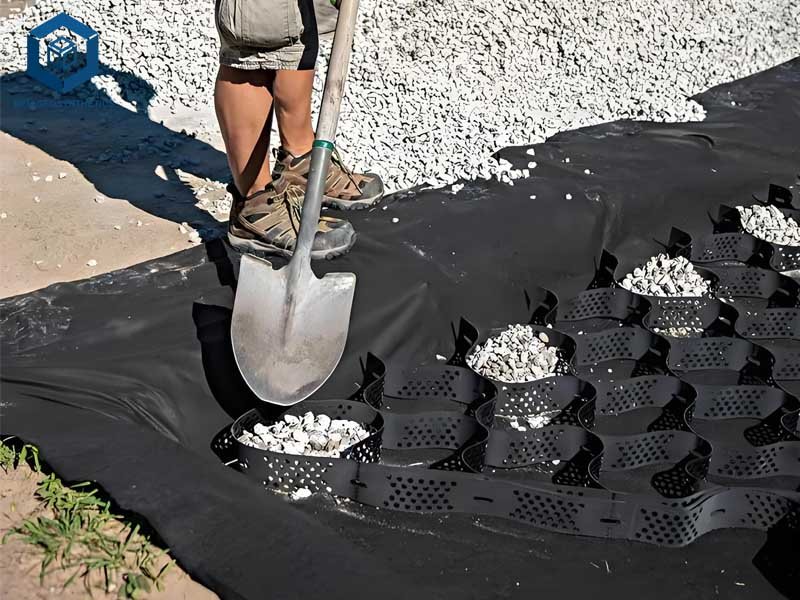
8. Cost Considerations for Geocell Projects
Geocell installation costs range from $4–$20/m², influenced by type, infill, and labor, per MarketsandMarkets (2024).
Cost Breakdown
- Material Costs: Perforated ($5–$15/m²), non-perforated ($4–$12/m²), NPA ($8–$20/m²), per geofantex.com.
- Infill Costs: Local gravel ($0.2–$0.5/m²) vs. imported ($0.5–$1.0/m²), per backyardbases.com.
- Labor Costs: $0.5–$1.5/m² for professional installation, per basecore.co.
- Site Preparation: $0.1–$0.3/m² for grading, per adspipe.com.
- Total: $5–$22/m², with bulk orders saving 10–20%, per bpmgeosynthetics.com.
Cost-Saving Strategies
- Local Infill: Reduces transport costs by 15%, per celltekdirect.com.
- Bulk Ordering: Saves 10–20% for ≥10,000 m², per GeoFanTex.
- DIY Installation: Saves $0.5–$1.0/m² for small projects, per backyardbases.com.
- Example: A 2024 U.S. highway saved $40,000 (15%) using local infill, per tencategeo.com.
9. Case Study: Successful Geocell Installation
In 2024, a Canadian highway project installed 30,000 m² of 6” perforated HDPE geocells from Presto Geosystems. The team compacted the subgrade to 95% density, used 3/4” gravel infill, and secured with 2 pins/m², achieving 40% improved load capacity and 50% erosion reduction. Bulk ordering saved $35,000 (15%), and annual inspections confirmed 95% performance, per prestogeo.com.
10. Final Thoughts
Geocells, with their 3D honeycomb design, transform geotechnical engineering by delivering 30–50% improved soil stability, 40–60% reduced erosion, and 15–25% cost savings, per Geosynthetics Magazine (2024). Offering tensile strengths of 10–30 kN/m, cell depths of 50–300 mm, and 20–50-year lifespans, they ensure 95% project reliability, per Geosynthetic Institute (2024). By selecting perforated, non-perforated, fabric, or NPA geocells based on project needs, verifying ASTM/ISO certifications, and using local infill, engineers can optimize performance and save 10–20%, per bpmgeosynthetics.com. Contact suppliers like BPM Geosynthetics for tailored solutions to elevate your 2025 projects. Share this guide to build sustainable, durable infrastructure.


